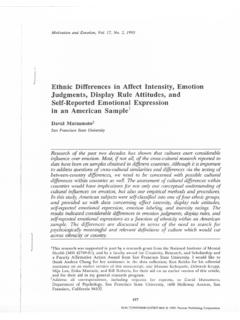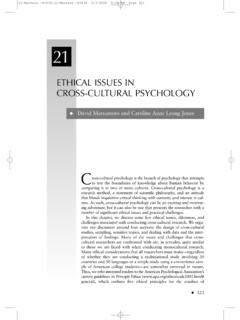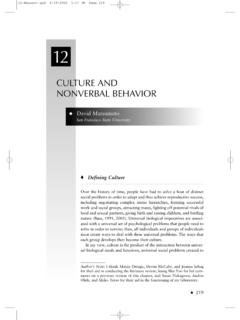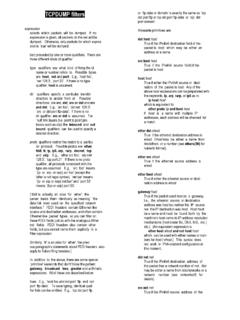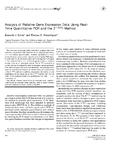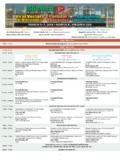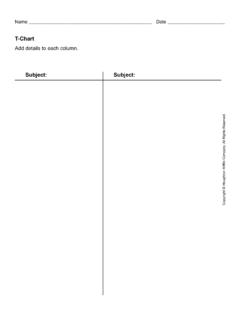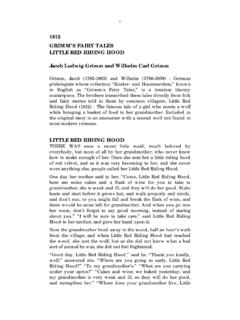Transcription of Culture and Emotional Expression
1 26315 Culture and Emotional ExpressionDavid MatsumotoThe relationship between Culture and Emotional expressions has long fascinated scholars and laypersons alike. In this chapter I review the evidence concerning this relationship and describe recent studies from my laboratory that answer major gaps in this literature. This new evidence indicates that facial expressions are universally produced in real-life, naturalistic settings when emotions are elicited, and that they are are universally recognized. Other new evidence, also reviewed in this chapter, indicates that facial expressions of emotion are universally produced by congenitally blind individuals.
2 Taken together, I believe that facial expressions of emotion are part of the response package of an evolved, biologically-based, core emotion the same time, there are many cultural differences in Emotional expressions. They are pro-duced via at least two mechanisms. The first is via cultural differences in norms of Expression management and regulation as a function of social circumstances. These are known as display rules (Ekman & Friesen, 1969), which influence Emotional expressions once emotions are elic-ited. This chapter reviews recent evidence from my laboratory involving a 30-country study of these rules and their implications for cultural differences in Expression second way in which cultural differences in expressions occur involves cultural differences in the kinds of events that trigger emotions (and thus expressions) in the first place.
3 I believe that one of the fundamental goals of enculturation is the calibration and adaptation of the universal, biologically-based, core emotion system to culturally available events, so that individuals learn to have appropriate Emotional reactions to events in their cultures. Because different events occur in different cultures or have different meanings in different cultures, individuals learn to have dif-ferent Emotional reactions across cultures, thus producing different , the evidence suggests a theoretical perspective on facial expressions of emotion that involves a biologically-based, core emotion system with cultural influences on the front-end pro-cessing of emotions, via calibration and adaptation of the core emotion system to culturally avail-able events.
4 And cultural influences on the back-end processing of expressions through cultural display rules (Figure ). The core emotion system, which humans are born with, serves as the central processor and is adapted for a multiplicity of uses within each Culture . We begin our review of the literature supporting this view by examining evidence for the universal production of facial expressions of FOR THE UNIVERSAL PRODUCTION OF FACIAL EXPRESSIONS OF EMOTIONThe study of Emotional expressions across cultures has its roots in the work of Darwin (1872/1998), who claimed, in his principle of serviceable habits, that facial expressions are the residual actions of more complete behavioral responses.
5 According to Darwin, all people, regardless of race or Culture , possess the ability to express some emotions in exactly the same ways, primarily through their faces. Darwin wrote The Expression of the Emotions in Man and Animals to refute the claims of Sir Charles Bell, the leading facial anatomist of his time and a teacher of Darwin s, about how 2639/4/08 6:47:45 AM264 Understanding Culture : Theory, Research, and ApplicationGod designed humans with unique facial muscles to express uniquely human emotions.* Relying on advances in photography and anatomy (Duchenne de Boulogne, 1862/1990), Darwin engaged in a detailed study of the muscle actions involved in emotion and concluded that the muscle actions are universal and that their precursors can be seen in the expressive behaviors of nonhuman primates and other s work, however, drew heavy criticism, especially from noted anthropologists such as Margaret Mead and Ray Birdwhistell.
6 They noted vast differences in expressive behavior across cultures and concluded the facial expressions could not be universal. Instead, they argued, emo-tional expressions had to be learned differently in every Culture , and just as different cultures have different languages, they must have different languages of the face as wasn t until a century later when Paul Ekman conducted the first studies to provide system-atic and reliable evidence for the universal Expression and recognition of emotion, including his well-known studies in New Guinea (Ekman, 1972; Ekman & Friesen, 1971; Ekman, Sorenson, & Friesen, 1969).
7 Ekman provided evidence that members of vastly different cultures could accu-rately and reliably recognize the emotions portrayed in a small set of facial expressions, including anger, disgust, fear, happiness, sadness, and surprise. He also demonstrated that people of very different cultures produced the same expressions spontaneously when emotions were actually elicited. Since Ekman s (1972) classic study, there have been at least 74 other studies that measured facial behaviors that occurred in reaction to emotionally-evocative situations, which reported that the facial configurations originally posited by Darwin (1872/1998) and verified (and somewhat modified) by Ekman (Ekman, 2003; Ekman & Friesen, 1975) actually occur (Matsumoto, Keltner, O Sullivan, & Frank, 2006).
8 These studies have involved a variety of emotion elicitation methodologies and participants from many different countries and glaring gap in this literature, however, was that all of these studies come from controlled, laboratory experiments. Critics of this literature (Feldman Barrett, 2006; Fridlund, 1997) have long questioned whether these facial expressions of emotion actually occur in real-life, naturalistic set-tings. These questions were entirely justified, as it is important to document that expressions occur not only in controlled, laboratory settings, but also in real-life recent study from my laboratory closed this gap by examining the spontaneous facial expres-sions of emotions produced by athletes competing for a medal at the 2004 Athens Olympic Games (Matsumoto & Willingham, 2006).
9 We examined the expressions of the 84 gold, silver, bronze, * To wit, Darwin penciled in the margin of Bell s book, He never looked at a monkey (Darwin, 1872/1998). Ekman s (1972) classic study involving American and Japanese participants is often misunderstood, so I describe it fully here. Participants viewed neutral and stressful films, and unbeknownst to them, their facial behaviors were recorded throughout the entire experiment. Ekman coded the last three minutes of facial behavior during the neutral films, and the entire three minutes of the last stress film clip using a modified version of Facial Affect Scoring Technique (FAST), a precursor to the FACS (Ekman & Friesen, 1978).
10 FAST identified facial configurations of six emotions: anger, disgust, fear, happiness, sadness, and surprise. But, the facial coding procedure was modified to include all lower face actions, rendering the coding equivalent to FACS. (The upper and middle face FAST codes already comprehensively assessed the FACS codes in these areas.) The generated codes corresponded to the facial expressions portrayed in the stimuli used in their judgment studies (Ekman, 1972; Ekman, Friesen, & Ellsworth, 1972; Ekman et al., 1969) and subsequently in the descriptions of the universal emotions in Unmasking the Face (Ekman & Friesen, 1975), in their stimulus set Pictures of Facial Affect (Ekman & Friesen, 1976), in Matsumoto and Ekman s (1988) Japanese and Caucasian Facial Expressions of Emotion set, and to the facial configurations identified as emotion signals in Ekman and Friesen s EMFACS (Emotion FACS) (Levenson, 2005; Matsumoto, Ekman, & Fridlund, 1991) coding system.



